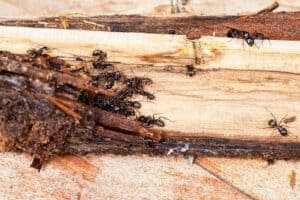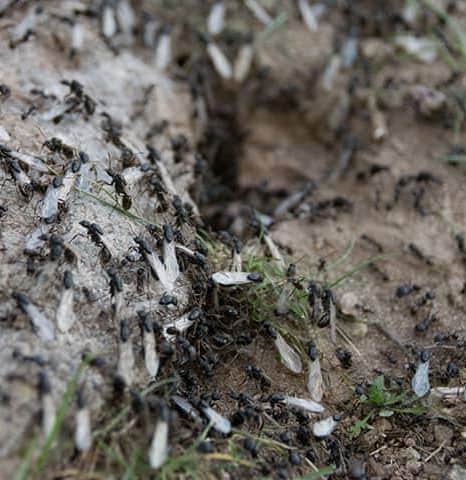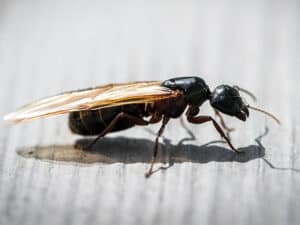For people living in Upstate New York, winged carpenter ants are common in summer. Many people confuse them with termites as they are larger and have wings. It’s definitely an unsettling site. This ant species can cause severe damage to homes and workplaces. With time, the colonies become stronger and present a real threat to people.
You might wonder if you can use a spray to get rid of winged carpenter ants. This, unfortunately, is just an incomplete quick fix and not a long-term solution. Winged carpenter ants grow in numbers very quickly, and the longer they’re left unattended, the worse the situation can become. That’s because these colonies multiply with time. Using a spray will only kill a bunch of foragers, but the main colony still exists.
Before applying any removal process, it is essential to know about their biology, life cycle, egg cycles, and such to understand what will work best. With knowledge you will be able to get rid of your carpenter ant problem in a safe, efficient manner.
Let’s dive into details about winged carpenter ants:
- How do they reproduce and form carpenter colonies?
- Why did these colonies become dangerous to humans?
- What measures can you take to eliminate these colonies?
Detailed Biology Of Winged Carpenter Ants
The winged carpenter ant has the biological name “Camponotus Pennsylvanicus.” It’s a North American species found all across the eastern United States. They are more common in the Northeastern parts of the US with large and dense hardwoods.
Carpenter ants exist in many different shapes and sizes. There are more than a thousand carpenter ant species globally, and the largest of them is the black carpenter ant.
Basic Structure
Black carpenter ants are large in size. While most appear to be a quarter of an inch, some can grow more than half an inch. This ant species has a single waist segment (or node). They can bite, but they don’t possess a stinger. Some people can easily confuse their size and wings with a termite. There’s a significant difference in structure, however.
Compared to termites, winged carpenter ants have a pinched waist and a bent antenna, and the top pair of wings are more significant than the bottom pair. Moreover, after swarming, there will be no piles of wings.
Eating Habits
Carpenter ants thrive on smaller insects. They also like honeydew coming from aphids, commonly known as greenfly or blackfly. There is a misconception that winged carpenter ants also eat wood – they don’t.
Reproduction
The reproduction process of winged carpenter ants is an attribute of their socializing nature. During the nuptial flight, male winged carpenter ants (also called ‘reproductives’) will fertilize the queen ant. After that, the males die. Hence, the queen is responsible for building a safe place for the eggs and taking care of them. After finding a proper place, the queen chews its wings and looks after the first batch of eggs until they start to turn into adults.
Growth Stages
Knowing about the growth stage of winged carpenter ants can help, especially when encountering multiple colonies in your home. So, you can plan an effective technique against them.
Different insects have two different types of metamorphosis: complete metamorphosis and incomplete metamorphosis.
Complete metamorphosis comprises of four stages: egg, larva, pupa and adult. The larva is very active and constantly eats before transforming into an inactive pupa.
Incomplete metamorphosis consists of three stages: egg, nymph and adult. Here, the nymph takes after a miniature adult. The nymph then transforms into an adult.
Carpenter ants belong to the group of insects that undergo complete metamorphosis. The adults can reach the age to become winged carpenter ants once the colony is mature.
Carpenter Ant Colony
Almost all ant species live in large groups, not just the carpenter ants, called ant colonies. Suppose you see those sizeable winged carpenter ants. Be very careful as there might be an ant colony nearby. Carpenter ant colonies will almost only establish in moisture diffused wood. Unfortunately, there can be many of these locations in and around your home in Upstate New York weather.
Interestingly, ants have predetermined roles. There are two groups among adults: reproductives and workers. The queen lays eggs while the other adults work around her to protect the colony.
The male winged carpenter ants (reproductives) fertilize the queen, making sure she lays eggs throughout her life. On the other hand, workers must perform multiple jobs to survive and extend their colony. Below, we’ll talk about why carpenter ants live in colonies and how they form them.
A colony of carpenter ants may survive up to 15 years if the queen is alive.
Why Winged Carpenter Ants Form A Colony
One of the primary reasons winged carpenter ants build ant colonies lies in the age difference between males and females. The female lives up to 15 years, and it keeps laying eggs throughout this period. At the same time, males survive for about a year or so. Therefore, ants’ colonies protect the queen, the eggs and the young ones.
Socializing and living together is another reason for building ant colonies. The adult carpenter ants look after the young ones and the queen. As they live together in an ant colony, it’s easy for the workers to bring food and store it for an extended period. The purpose of storing food is to survive through tough times when there’s a shortage of food due to bad weather or blockages.
Ant colonies offer protection from external threats, like:
- Attacks by other animals, bees, termites and other more giant insects
- Weather conditions: rain, strong winds, snow, etc.
How Do Winged Carpenter Ants Form A Colony
As discussed above, the winged carpenter ants die after fertilizing the queen, and she finds a secluded place to lay eggs. But before laying eggs, the queen gets rid of her wings by chewing them off. After that, she initiates the colony-building process and manages to build it enough to lay the first group of eggs. This entire group gets all the attention of the queen till it reaches maturity.
The queen then transfers the babysitting responsibility to the adults and focuses on other affairs of the ant colony. She controls the workers and regulates all the activities. Meanwhile, the workers perform multiple tasks, such as bringing in food, feeding the larvae, building nests, repairing works, defending their nests, etc.
Among those larvae, there are female ants, and they need protection until they reach the age of maturity. Once they’re ready to fly, they leave the old colony to start a new one. These flying ants signify that the ant colony has matured and will produce swarms of winged carpenter ants. Also, most people realize the extent of the problem at that moment. Winged carpenter ants will only form when the colony is mature. The delay in winged activity is because reproductive stages do not assist in the colony’s development. According to Cornell Cooperative, a mature winged carpenter ant colony will typically have between 5,000 – 20,000 ants.
What An Ant Colony Means To Humans
Carpenter ants can build large ant colonies. After creating the central nest (the main colony), they move on to build satellite nests that exist at a specific distance from the primary location. To ensure accessibility, they develop a tunneling system that connects the central nest to multiple satellite nests. If there’s an ant colony in your house, it must be developing into something bigger.
If you observe winged carpenter ants inside or outside your house, it’s a sign that there’s a mature ant colony somewhere not too far. Ant colonies can exist on any hidden location, including tree stump or hollow tree, beneath the windowsills, chimneys, insulation cracks, etc.
Worker ants stay near the central nest. They can go as far as 30 feet, but not more. So, if you find a carpenter ant in your room or kitchen, there’s a high chance that a colony is present inside the house.
Why An Ant Colony Can Be A Threat To Your House
While carpenter ants don’t have a poisonous sting, they can bite and chew. They can damage the wood floor or create holes or cracks in your wall insulation to build tunnels or a nesting spot. Not only that, but they can also bite away soft foams to create a space for themselves.
For instance, the cracks in your home insulation give way to water and air that can further open those cracks. Moreover, they can dig into moist wood to create tunnels. This process, in turn, may result in different types of structural damage to the building.
This damage may not be as frightening at first. But there’s the likely possibility that what lies beneath the visible damage is worse. If you don’t locate hidden nests and tunnels and get rid of the pests for good, the cost of the damage could skyrocket.
Inspection
To eliminate the winged carpenter ants yourself, you need to locate all the nests and tunnels. It is essential to remove all the colonies, their main nest, satellite nests, and tunnels. To find these areas, most professional companies will:
Look For Live Ants
You can find them on stairs, foundation, cable wires, porch, etc. The best time to look for them is night, as carpenter ants are nocturnal. In contrast, winged carpenter ants can be active during the day. You might find them in shady areas outside of the house.
Look For Traces of Sawdust (Frass)
Carpenter ants turn the wood into sawdust. Therefore, you should inspect the wooden floors, furniture, cupboard, etc., and look for traces of sawdust. You might find traces near the walls, windows, attic.
Winged Carpenter Ants Are Near The Nests
You can search for them beneath the windowsills, fiberglass insulation, wall voids, staircases, curtain rods, etc. Winged carpenter ants are pushed out of the colony and typically near the colony.
Find The Main Colony
All nests connect to the main nest. There may be a possibility that the main colony exists somewhere hidden like a crawl space or inaccessible part of the basement. You should also check your chimney or exterior wall interruptions from the inside and outside.
Prevention Techniques
There are different prevention techniques to rid of winged carpenter ants. These include:
Vacuum Up Winged Carpenter Ants
You can use this technique to vacuum the entire colony of carpenter ants. But make sure to destroy the vacuum debris. You may need professional help, as eliminating the ants’ waste can be difficult.
Do The Repairs
You can trim the tree limbs or bushes that touch your home walls. Seal all the cracks on the walls, pipes, and electric panels with the help of a caulk. Remove firewood from the floor and store it at a certain distance from your home.
Reduce Moisture

Carpenter ants like places where there is excessive moisture and water-damaged wood. These are hospitable places for them so reduce these spots if you have any. Also, please pay attention to your drainage system to keep it clean and dry.
Use A Bait
Use a liquid insecticide bait near ant tracks, ant colonies and other possible places. If you observe the number of ants increasing around the bait, that’s a positive sign. Toxic baits may take up to 60 days to kill of the entire ant colony.
Apply Low-Toxic Chemicals
If the above techniques can’t stop the winged carpenter ants, you can use these registered chemicals:
- Pyrethrum
- Diatomaceous Earth
- Silica Aerogel
- Boric-acid
Apply these chemicals to the places discussed above. But make sure to read the label before use.
Why Hire Professional For Winged Carpenter Ants
To eradicate winged carpenter ants from your house, you may need to hire a professional service. As you have learned that killing a handful of ants is not the solution, an in-depth inspection will be more than helpful. For this purpose, you can hire a professional service like EnviroPest Ant Exterminators to handle all your needs.
Two main reasons for hiring a professional:
Professional Inspection
Inspection for the winged carpenter ants may take some time and effort, which may be challenging to conduct independently. Moreover, professionals use the right tools to reach places the average homeowner cannot get as easily. They know how to prevent any surprise attack from these insects while guarding their eggs.
Controlled Techniques
There are different techniques to rid of winged carpenter ants. It is usually best to use a professional service. Professionals can locate their trails, but they also have the proper techniques to remove the entire ant colony. For example, if there’s a need to use a low-toxic chemical to rid the winged carpenter ants, they will take all the precautionary measures to ensure the safety of your house and its environment.
Many homes in Upstate New York will find winged carpenter ants this spring. It’s one of the largest ant species found in abundance in northeast America. These species live in ant colonies started by a mature female carpenter ant (queen). She gets fertilized during the nuptial flight by the male winged carpenter ants.
The queen ant regulates ants’ colonies while workers have different roles, including taking care of eggs and larvae, arranging for food, feeding larvae, repairing the colony, building satellite nests and tunnels, etc.
When you see these winged carpenter ants in your home, take immediate measures to get rid of them. There are many ants in the colony, and they are likely doing severe structural damage. A thorough inspection followed by different prevention techniques is recommended. However, it would be better to hire a professional like EnviroPest.



